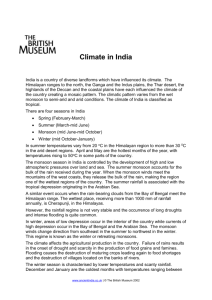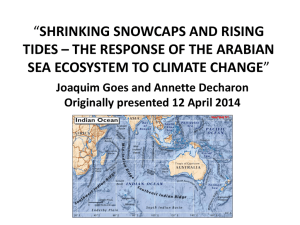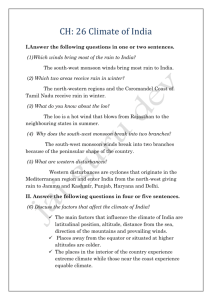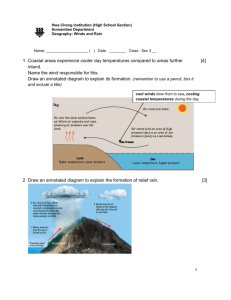Handout - Monsoon
advertisement
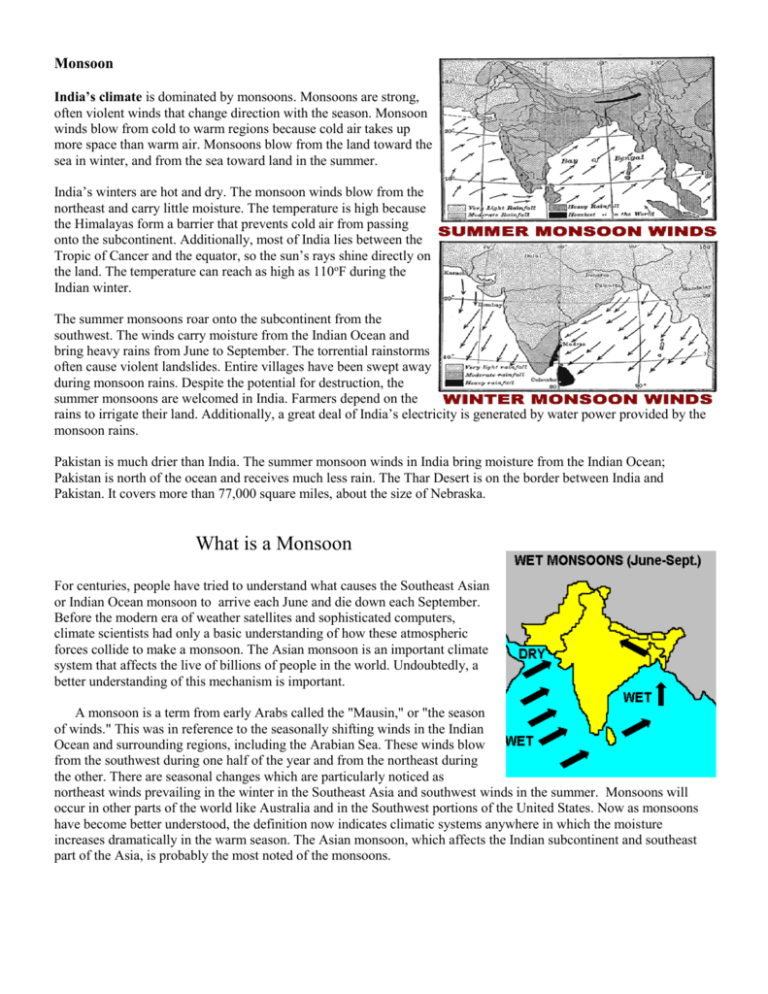
Monsoon India’s climate is dominated by monsoons. Monsoons are strong, often violent winds that change direction with the season. Monsoon winds blow from cold to warm regions because cold air takes up more space than warm air. Monsoons blow from the land toward the sea in winter, and from the sea toward land in the summer. India’s winters are hot and dry. The monsoon winds blow from the northeast and carry little moisture. The temperature is high because the Himalayas form a barrier that prevents cold air from passing onto the subcontinent. Additionally, most of India lies between the Tropic of Cancer and the equator, so the sun’s rays shine directly on the land. The temperature can reach as high as 110oF during the Indian winter. The summer monsoons roar onto the subcontinent from the southwest. The winds carry moisture from the Indian Ocean and bring heavy rains from June to September. The torrential rainstorms often cause violent landslides. Entire villages have been swept away during monsoon rains. Despite the potential for destruction, the summer monsoons are welcomed in India. Farmers depend on the rains to irrigate their land. Additionally, a great deal of India’s electricity is generated by water power provided by the monsoon rains. Pakistan is much drier than India. The summer monsoon winds in India bring moisture from the Indian Ocean; Pakistan is north of the ocean and receives much less rain. The Thar Desert is on the border between India and Pakistan. It covers more than 77,000 square miles, about the size of Nebraska. What is a Monsoon For centuries, people have tried to understand what causes the Southeast Asian or Indian Ocean monsoon to arrive each June and die down each September. Before the modern era of weather satellites and sophisticated computers, climate scientists had only a basic understanding of how these atmospheric forces collide to make a monsoon. The Asian monsoon is an important climate system that affects the live of billions of people in the world. Undoubtedly, a better understanding of this mechanism is important. A monsoon is a term from early Arabs called the "Mausin," or "the season of winds." This was in reference to the seasonally shifting winds in the Indian Ocean and surrounding regions, including the Arabian Sea. These winds blow from the southwest during one half of the year and from the northeast during the other. There are seasonal changes which are particularly noticed as northeast winds prevailing in the winter in the Southeast Asia and southwest winds in the summer. Monsoons will occur in other parts of the world like Australia and in the Southwest portions of the United States. Now as monsoons have become better understood, the definition now indicates climatic systems anywhere in which the moisture increases dramatically in the warm season. The Asian monsoon, which affects the Indian subcontinent and southeast part of the Asia, is probably the most noted of the monsoons. A monsoon seasonal change is characterized by a variety of physical mechanisms which produce strong seasonal winds, a wet summer and a dry winter. All monsoons share three basic physical mechanisms: differential heating between the land and oceans; Coriolis forces due to the rotation of the Earth; and the role of water which stores and releases energy as it changes from liquid to vapor and back (latent heat). The combined effect of these three mechanisms produces the monsoon's characteristic reversals of high winds and precipitation. Scientists say that the two key ingredients needed to make a monsoon are a hot land mass and a cooler ocean. In India, for instance, the land absorbs heat faster from the sun than the surrounding Indian Ocean does. This causes air masses over the land to heat up, expand, and rise. As the air rises, cooler, moister, and heavier air from over the ocean will replace it.. Over India, this damp, cool layer can be up to three miles thick. As the cool air arrives, the winds also shift. During the dry season, the winds blow offshore, from land to sea. Then, as the monsoon begins, the winds blow onshore, from sea to land. In the case of the Indian Ocean Monsoon the first and third mechanisms produce more intense effects than any other place in the world. Southeast Asian winters are considered to be hot and dry. That is were their name comes from; dry winter monsoons which will occur from September to March.. The winds from the northeast during the winter months are dry because they have lost their moisture on the Asian land mass. The cold air from the middle of the continent cannot reach the portion of Southeast Asia. The reason for this is the Himalayas act as a huge wall blocking this cold weather and causing high temperatures. The dry winters comes from the fact that what little moisture that comes toward this area is also blocked by the Himalayas. There is one exception to this area. That would be the tip of the peninsula of India. As the winds blow toward the peninsula they seem to pick up some moisture from the Bay of Bengal. This little tip then receives a majority of its rainfall during these months. Of particular interest is the Indian summer monsoon which takes place from June to September with prevailing winds from the southwest and heavy rainfall. This time of the year is called the wet summer monsoon and ranges from June to September. The Indian summer monsoon typically covers large areas of western and central India receiving more than 90% of their total annual precipitation during the period, and southern and northwestern India receiving 50%-75% of their total annual rainfall. Overall, monthly totals average 200-300 mm over the country as a whole, with the largest values observed during the heart of the monsoon season in July and August. In all total India in 2000 received 770 mm of rainfall which is slightly below average. But the last eleven years have all been around average rainfall. Based on 80 years of data, major droughts have been associated with warmer than normal sea surface temperatures (SST) in the equatorial Eastern Pacific for time periods spanning a monsoon season. Floods, on the other hand, have been associated with cooler SST events in the tropical Eastern Pacific. And high winter Eurasian snow have been linked to weak rainfall in the following summer Indian monsoon. Some key parameters for monsoons include: surface temperature (both land and ocean), precipitation, and wind fields. How much rain is does this area get in comparison? These are yearly precipitation estimates for some selected cities extracted from the GEOS-1 Multiyear Assimilation. Calcutta and NW Burma are in the heart of the Indian monsoon region.





